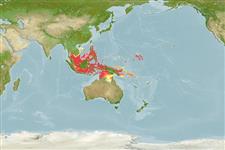Environment: milieu / climate zone / depth range / distribution range
Ecologia
marinhas; estuarina demersal; intervalo de profundidade 2 - 30 m (Ref. 126081). Tropical
Indo-Pacific: tropical to subtropical waters; southeastern Indian and western Pacific oceans (recorded from Japan, East China Sea, Taiwan, Philippines, Vietnam, Singapore, Indonesia, Papua New Guinea, Samoa, and Australia),
Tamanho / Peso / Idade
Maturity: Lm ? range ? - ? cm
Max length : 38.0 cm TL macho/indeterminado; (Ref. 4900)
Descrição breve
Chaves de identificação | Morfologia | Morfometria
Raios dorsais moles (total) : 64 - 76; Raios anais moles: 51 - 62; Vértebras: 41 - 44. This species is distinguished by the following set of characters: D 64-76 (mode 71); A 51-62; pored lateral line scales on straight portion 93-126 (118); vertebrae 41-44 (43); pectoral-fin rays on ocular side 4-7 (6) and on blind side 4-7 (5); pelvic-fin rays on ocular side 4-6 (5) and blind side 4-5 (4); caudal-fin rays 13-15 (14); body slightly elongate, its depth 40.0-51.0 (mean 45.5)% SL; head length 16.1-23.9 (18.6)% SL; pectoral fin on ocular side longer than that on blind side, 5.3-7.6 (6.6)% SL vs. 4.0-6.0 (4.8)% SL; pelvic fin on ocular side longer than that on blind side, 4.9–7.4 (6.0)% SL vs. 4.3–7.5 (5.8)% SL; body depth below lateral line 21.7-27.1 (23.4)% SL; lips without labial papillae; eyes separated by scaled interorbital space; cycloid or weakly ctenoid scales on blind side. Colouration: body on ocular side uniformly brown or grey with dark vermiculation, some small white blotches along dorsal- and anal-fin bases, or no remarkable pattern (Ref. 126081).
Inhabits sheltered bays and lagoons on pale sandy substrates near reefs (Ref. 48637). Collected froom from shallow marine and estuarine waters in less than 5 m; but there are underwater photographs of individuals on shallow sandy bottoms between 2–30 m depth (Ref. 126081).
Life cycle and mating behavior
Maturidade | Reprodução | Desova | Ovos | Fecundidade | Larvas
Okamoto, J.O. and H. Motomura, 2021. Redescription of Brachirus aspilos (Bleeker 1852), a senior synonym of four nominal species, with a note on the distribution of Dagetichthys marginatus (Boulenger 1900) (Pleuronectiformes: Soleidae). Zootaxa 4908(3):354-368. (Ref. 126081)
Categoria na Lista Vermelha da IUCN (Ref. 130435: Version 2024-1)
Ameaça para o homem
Harmless
Utilização humana
Ferramentas
Relatórios especiais
Descarregue XML
Fontes da internet
Estimates based on models
Preferred temperature (Ref.
123201): 21.1 - 28.4, mean 27.1 °C (based on 499 cells).
Phylogenetic diversity index (Ref.
82804): PD
50 = 0.5000 [Uniqueness, from 0.5 = low to 2.0 = high].
Bayesian length-weight: a=0.00977 (0.00466 - 0.02049), b=3.07 (2.90 - 3.24), in cm total length, based on LWR estimates for this (Sub)family-body shape (Ref.
93245).
Nível Trófico (Ref.
69278): 3.7 ±0.4 se; based on size and trophs of closest relatives
Resiliência (Ref.
120179): Médio, tempo mínimo de duplicação da população 1,4 - 4,4 anos (Preliminary K or Fecundity.).
Fishing Vulnerability (Ref.
59153): Low to moderate vulnerability (28 of 100).
